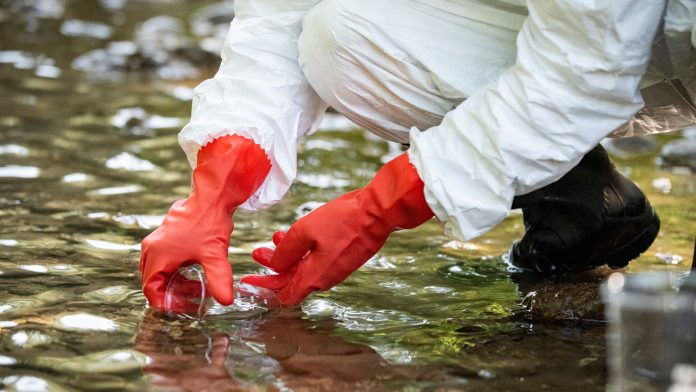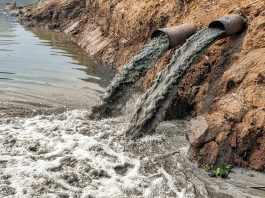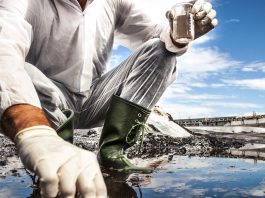As urbanisation continues to change our natural landscapes, we must find ways to put water quality monitoring in the hands of local communities to mitigate water pollution.
Rivers and streams throughout the world are facing unprecedented stressors. Urbanisation is ever increasing and the construction of buildings, roads, residences, industries, sewage treatment systems, population centres, parks, and recreational centres around our rivers and streams is advancing. Agricultural development is even more pervasive, with runoff from pastures, croplands, animal processing facilities, septic tanks, and waste lagoons all affecting the natural environment.
The extent of this water pollution is causing stressors throughout our aquatic ecosystems that will eventually become out of our control. With every major weather event we witness the impact of urbanisation as excessive sediment and erosion mixed with microplastics, pathogens, and toxic materials flow down our rivers and into our sea. We need to work to improve and control these problems, but a fundamental question remains. How do we test and document the problem in a way that actively engages stakeholders? We need to show visible improvement from our efforts to encourage and expand water monitoring, otherwise the continued expenditure of time and money could be perceived as wasteful. In order to be effective, we must actively hold ourselves accountable.
Important steps
An important step in the process of defining and tackling the problems of urbanisation is the creation of a clear definition of end-point indicators for stream health. The water quality of the world’s streams and rivers are often communicated in somewhat subjective terms such as ‘swimmable’ or ‘good’, but what do these descriptors actually tell us? These are subjective terms and cannot easily be enforced, they do not describe in any detail what the extent of water pollution in a particular body of water may be. Whilst such terms as ‘swimmable’ are generated for public use and understanding, the measures reinforcing these declarations are scientific and complex.
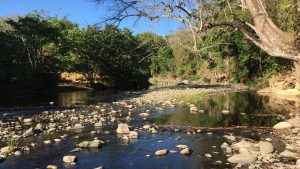
But here lies another paradox: scientists command a monopoly on the derivation of these indicators and tend to move the science toward greater complexity rather than simplicity. This means that when these terms become intertwined into governmental regulation and environmental law, the people most impacted by a water polluter or water pollution event, local communities, quickly understand that finding a solution is very onerous. This process creates endless study and engineering while producing very little change and, in the end, it is the streams and the communities that suffer.
By replacing these terms with measures that define water pollution by its impact upon local communities we can create measurable endpoints that are easily understood and can be contributed towards by members of the public.
Scientific indices developed in North America and Europe to successfully predict water quality are currently used by the scientific community. Significant regulatory and academic research surrounds the creation of these indices but movement towards involving the public has not been robust. Part of the problem is education; whilst universally acknowledged as necessary for the promotion of environmental protection, education is a complex issue. People formulate perceptions about the environment from their experiences, influences, and attitude-behaviour measures. It can be difficult to motivate and educate a citizen scientist and any work produced is perceived as ancillary to professional water science. But a growing body of scientific literature suggests citizen science is effective and can monitor water quality. An educated public directly impacted by water pollution, if properly equipped, are the very best advocates to motivate water health and to press regulators, academics, and law enforcement to work towards meaningful change.
Water pollution in Latin America and the tropics
When considering the current state of water quality in Latin America and the tropics, the transferability of European and North American scientific indices has been difficult. Heavy seasonal rains generate excessive disturbances and there is a very different weather and environmental system than in other parts of the world. River management and sanitation is not prioritised by governments as generating quality drinking water remains the greatest concern and commands the most resources. These regions now face changing precipitation patterns along with increasing land use, and population patterns making management more challenging. So, how can effective water management be achieved in these regions?
In Costa Rica, the desire for clean water is clear and set forth as a key priority by government decree. The Executive Order explains the need to recover and preserve the physical, chemical, and biological integrity of the surface water bodies of Costa Rica so that these waters can be used for different social, economic, and environmental purposes that contribute to the development of the country, thus ensuring a better quality of life for all its citizens.
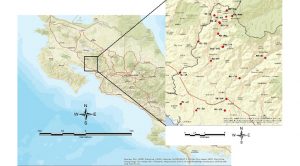
To achieve this goal, clear endpoints are set forth describing water quality using various chemical and biological measures, and scales are set to indicate water quality ranging from excellent to poor condition. Whilst these indices provide policy makers and scientists with a needed end-point assessment, critical baseline water quality monitoring along with rigorous testing and validation is sorely lacking. Furthermore, the complex collection and computation of such indices limits accessibility throughout communities where local water boards are tasked with improving sanitation and water quality.
As reported in The Costa Rica News, water quality and its rational use and conservation by a participating public is of the greatest need. Therefore, these indices imbedded into a policy framework only testable by rigorous methodology disseminated through scientific literature isolates a participating public. In order to empower communities, the tools to test and understand water quality need to be comprehensively understood and accepted on a wide scale.
Along a three-river corridor in the north central pacific slope of Costa Rica (see Fig. 2), we researched the effectiveness of a suite of water quality indicators based upon a multitude of factors such as complexity, effectiveness, spatial applicability, and seasonality. We wanted to first find an indicator that was workable for the predication of water quality in tropical environments. Once we made this determination, we then set forth to make such an indicator accessible for use by communities.
Our ultimate goal is to drive public participation into the governance of water through direct application rather than end use of information. While public education and participation is often complex, direct involvement in the creation of scientific indices and understanding of the science surrounding local water management and quality helps break down preconceived barriers and builds a greater cohesion toward a common goal.
We tested both a chemical-based index – top graph a) in Fig. 3 – and a biologically based index – bottom graph b) in Fig. 3 – suggested as end point indicators from the government decree to determine how well each of these indices predicated water quality. The water chemistry index was predictive and useable however as shown in Fig. 3 strongly influenced by other chemical variables such as TSS (concentrations of solids in the water), E. coli (concentration of bacteria in the water), Cond (the number of dissolved solutes in the water) and percentage of saturation (the amount of oxygen in the water). All of these variables require technical expertise and equipment that is usually unavailable to communities. Hence, whilst this chemical index is useful for scientific and regulatory use, it is not an accessible tool for communities.
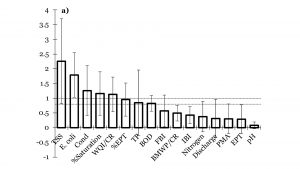
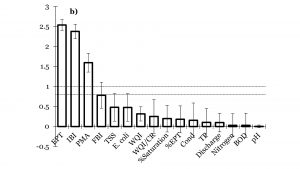
On the other hand, we further tested a biologically-based index in conjunction with the chemical index. First, we correlated this index to the chemical parameters for validity. We wanted to assure this index predicted water quality as good as or even better than the chemically based index. Secondly, we wanted to explore how this index was constructed to determine its efficacy for use in communities. We found the biologically-based index was actually better at prediction than the chemical-based index. This finding was significant because the biological indicators (stream insects) are easily accessible and simple to identify for communities. However, the biological index tested here is also complex. It requires a strong ability to differentiate between the taxonomic groups of insects and this is often beyond the expertise levels of communities. But within this finding we discovered something else: this index was strongly driven by much simpler biological indices to calculate – EPT, IBI and PMA. The simpler versions use the number of insect families represented by mayflies, stoneflies, and caddisflies and can be easily taught to communities for identification. Through minimal training, communities can closely monitor the changing proportions of these insects to keep a watchful eye on the communities’ water health.
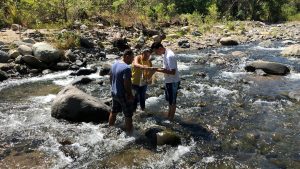
Future impact
Implications for these findings are widespread. Monitoring water pollution is essential for regulators but even more importantly for the public, people must have confidence that water is regulated toward their best interest. The finding that a simple index is capable of predicting water quality in the tropics, and that these insects were actually better predictors than the water chemistry levels means it is possible to bring in the public as monitors of water quality. While the populations of insects are impacted by changing seasons, overall, we found they do consistently predict changes due to human disturbance. Accumulating data using simple tests to determine proportions of the EPT insects can help build vast databases that reveal important information on the health of a river, instead of more laborious efforts to quantify water quality, simplification works better in a community context.
Further implications suggest groups of individuals throughout communities measuring water quality can exponentially increase our understanding of environmental impact on scales we cannot achieve through academic science alone. And the arbitrary classifications of ‘swimmable’ or ‘good’ can be verified by the people directly impacted.
Simple but clear water quality indices when tracked under the watchful eye of community organisations who actually know how to use them can help change our idea of water management. Instead of management based on policy objectives that often do not bear a one-on-one, logical relationship to water in our communities, water policy can shift to accommodating a swift adaptation to societal needs, leading to residents showing greater support for the expenditure of funds as they can clearly understand the benefit.
Please note, this article will also appear in the seventh edition of our quarterly publication.

